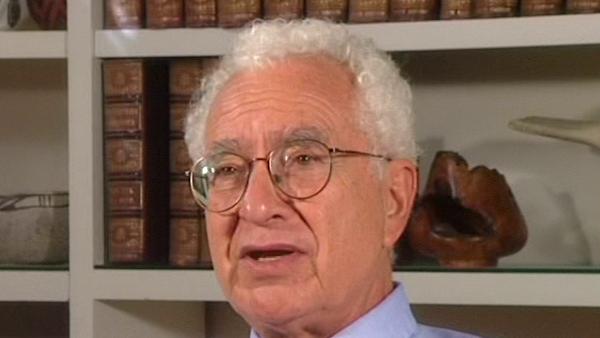NEXT STORY

The fourth quark
RELATED STORIES

NEXT STORY

The fourth quark
RELATED STORIES


|
Views | Duration | |
|---|---|---|---|
| 141. Giving a paper at SLAC. David Politzer | 737 | 01:35 | |
| 142. The idea of QCD takes hold | 590 | 01:52 | |
| 143. Feynman and QCD | 1727 | 00:56 | |
| 144. Strings and bootstraps. The Veneziano model | 700 | 03:02 | |
| 145. People at CERN. Veneziano's theory, string theory, bootstrap... | 669 | 01:24 | |
| 146. Pierre Ramond, John Schwarz and André Neveu; superstring... | 783 | 01:16 | |
| 147. The importance of superstring theory. Dimensionality | 776 | 03:10 | |
| 148. Getting the Nobel Prize | 3 | 967 | 03:16 |
| 149. Sight-seeing in Stockholm | 855 | 02:39 | |
| 150. Electro weak and charm | 543 | 03:22 |


I was very excited about the mixing in a... some sort of generalized Yang-Mills theory, the weak and the electromagnetic interactions. I always wanted to do it. After 1957 when the weak interaction was, when it appeared that the weak interaction was vector and axial vector - confirmed later in ’58, ’59 - it became much more… much easier than when we had to cope with the scalar and tensor nonsense. So I worked on that and I endorsed Shelley’s model of how to do it... gave the speech about it in Rochester, which I think was the only intelligible presentation of… of his model. And that’s persisted to this day, that's the same model we use now: SU(2) x U(1). Then Stephen Weinberg, around 1967, added to that the soft mass mechanism that I had been advertising for... for some years using the sigma model, actually, and using the mechanism of Phil Anderson, and Higgs and Kibble and all these other people. That was a beautiful piece of work. It didn't completely clear up though all the issues. We still needed charm, and although Bjorken and Glashow had suggested charm—when was that? 1964 I believe—as an idea—they didn't propose it immediately as a solution to all the various problems of the strangeness changing neutral current. Because the charm current cancels out a lot of the problems caused by the strangeness changing… the ordinary strangeness changing neutral current. When was that? 1970 I think that..? Which, the..? That Bjorken and… and Glashow returned to… to that issue, or somebody did. Well there was the Glashow..? When was charm reasserted as the solution to the various problems? Glashow, Illiopolos and Maiani... Oh, that's what it is: Glashow, Illiopolos and Maiani. Right. Right. In '60, well...? ’70, I think. ’69. ’69 or ’70. Yeah, I was at… mid Harvard at the same time. Right, anyway that cleared up a lot of things. And all these hesitations that I had had over whether to make an analogy between three leptons and three quarks, or four leptons and four quarks and so on and so on, all of that was settled then. We definitely had four leptons, electron and its neutrino muon and its nutrino. With the charm we had four quarks and the various problems with the weak interaction theory were… were pretty much laid to rest.
New York-born physicist Murray Gell-Mann (1929-2019) was known for his creation of the eightfold way, an ordering system for subatomic particles, comparable to the periodic table. His discovery of the omega-minus particle filled a gap in the system, brought the theory wide acceptance and led to Gell-Mann's winning the Nobel Prize in Physics in 1969.
Title: Electro weak and charm
Listeners: Geoffrey West
Geoffrey West is a Staff Member, Fellow, and Program Manager for High Energy Physics at Los Alamos National Laboratory. He is also a member of The Santa Fe Institute. He is a native of England and was educated at Cambridge University (B.A. 1961). He received his Ph.D. from Stanford University in 1966 followed by post-doctoral appointments at Cornell and Harvard Universities. He returned to Stanford as a faculty member in 1970. He left to build and lead the Theoretical High Energy Physics Group at Los Alamos. He has numerous scientific publications including the editing of three books. His primary interest has been in fundamental questions in Physics, especially those concerning the elementary particles and their interactions. His long-term fascination in general scaling phenomena grew out of his work on scaling in quantum chromodynamics and the unification of all forces of nature. In 1996 this evolved into the highly productive collaboration with James Brown and Brian Enquist on the origin of allometric scaling laws in biology and the development of realistic quantitative models that analyse the influence of size on the structural and functional design of organisms.
Tags: Rochester, Stephen Weinberg, Phil Anderson, Peter Higgs, Tom WB Kibble, James Bjorken, Sheldon Lee Glashow
Duration: 3 minutes, 23 seconds
Date story recorded: October 1997
Date story went live: 29 September 2010